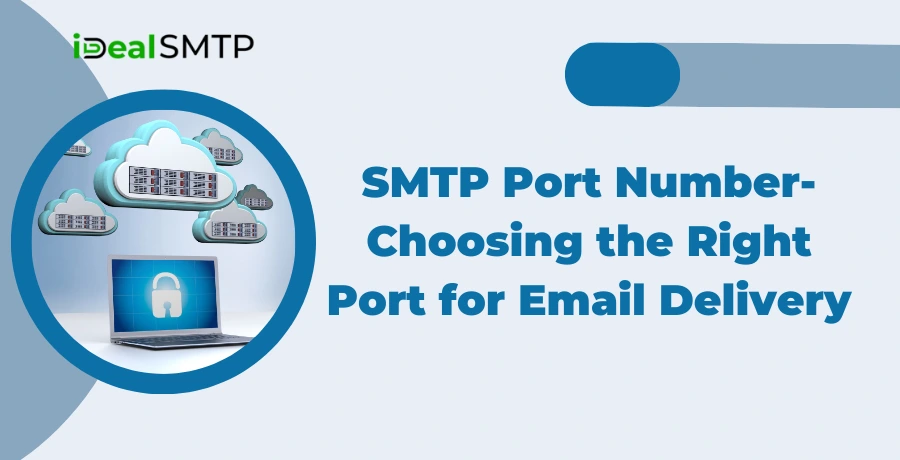SMTP or Simple Mail Transfer Protocol is the protocol that is used for mailing messages on the internet. Before setting up an email server or a client, it is pertinent to choose a suitable SMTP port number to guarantee a secure message transmission process. Picking the correct port helps to avoid some widespread problems, such as blocked e-mail or errors in the authentication process.

Let me start with some basics here and then I will explain them to you in detail In this blog, I will define SMTP ports. Why they are important? How to select a proper port for your email service?
Table of Contents
Pricing
| Trail Plan | Standard Plan | Premium Plan | Professional Plan |
| $50 | $145 | $185 | $225 |
| Sending Limit | Sending Limit | Sending Limit | Sending Limit |
| 1000 Emails/Hour | 1500 Emails/Hour | 3000 Emails/Hour | 5000 Emails/Hour |
What is an SMTP Port?
What is an SMTP Port Number?
In networking, one can refer to a port number as being similar to the address used in socket communications in that it provides an identifier on which device to send data to or where data is coming from. SMTP exists on the TCP/IP and acts on stated channel numbers, which are used for handling the traffic of email. These port numbers inform the email client and server which ‘channel’, and every SMTP port is different concerning email delivery.
Popular SMTP port numbers include port 25, 465 for SMTPS, port 587 for submission, and 2525. Understanding the application of each can, thus, make it possible to identify the right tool depending on your requirements.
Overview of SMTP Port Numbers
SMTP Port 25:
- Usage: This in the past was the standard SMTP port used when swapping messages between mail servers.
- Details: Although port 25 is assigned for mainstream email use, it should be noted that it is restricted to server-to-server transfer of emails and should not be used for client-submitting emails. It is transparent and blocked by ISPs as they found this open relay port exploited massively in the past.
- Best For: Is used in conveying mail from one mail server to another, especially in a controlled network.
SMTP Port 465 (SMTPS):
- Usage: Formerly given for SMTPS over SSL, TCP port 465 is not frequently recommended as it is today but is supported.
- Details: This port affirms secure sockets layer/transport layer security connection for emails and is useful in passing contents securely. Older systems still use this port for encrypted connections although it is not recognized as a standard port.
- Best For: Services that demand the utilization of the secure SMTP over port 465; majorly are those which are obsolete or have specialized systems.
SMTP Port 587:
- Usage: The port suggested for e-mail submission (from client to server).
- Details: Port 587 also supports the transmission of messages that have an encrypted layer over their standard port through STARTTLS expansion of the SMTP function. It is the default port used for providing secure transmission of messages for purposes of email authentication and encryption.
- Best For: Almost all contemporary mail clients and servers utilize port 587 for a trustworthy and secure POST method submission.
SMTP Port 2525:
- Usage: One of the standard variants of 587, selected where other ports are closed by ISPs or networks.
- Details: The port 2525 is not standard in the SMTP, but it is widely used by many mail service providers. Authenticated Email Submission Protocol is used for this service and it supports TLS encryption.
- Best For: Cases where port 587 is restricted or for general and other port number settings.
How to Choose the Right SMTP Port for Your Setup
Determining which SMTP port to use depends on your current network environment, restrictions imposed by your current Internet Service Provider, and the level of security desired. Here’s a quick guide to help you decide:

- For Reliable Email Submission: Use port 587. It’s the one that is used to ‘send out’ messages from an email client to a mail server and supports both authentication and encryption.
- For Encrypted Legacy Systems: Port 465 is still capable of being used with many systems from older generations that offer the SSL/TLS protocol for communication.
- For Server-to-Server Communication: Port 25 is the most suitable for recommendation in server-to-server relay within an organization’s LAN but unsuitable for general acceptance by another mail server.
- For Flexibility When Other Ports Are Blocked: As for now, Port 2525 is considered to be the best in terms of bypassing ISP restrictions because it’s supported by almost all email providers.
Common Pitfalls and Tips for Using SMTP Ports
ISP and Network Restrictions: That is why some ISPs and networks use port filtering, for example, blocking port 25 and port 587 to limit spammers. When using a certain port make sure that the port you have chosen is cleared by your ISP or network admin.
Enable STARTTLS: If the port number is 587 or 2525 should be enabled with STARTTLS. This will ensure that your email is encrypted during transfer to ensure that any sensitive information is safe.
Authenticate the Connection: Typically, ports 587 and 2525 should be used for authorized connections because they are easier and safer for the client-to-server connection than others.
Monitor Email Deliverability: Some of the SMTP ports may have on or off-link spam filters or delivery rates. Track your email campaigns and check periodically to determine if your chosen port has any negative impact or not on deliverability.
Security Considerations for SMTP Ports
This has always been important and necessary to ensure that spam, phishing attacks, and unauthorized access to an SMTP are prevented. Here’s how security factors into each port choice:
Encryption Protocols:
Port numbers 465, 587, and 2525 support encrypted sockets like SSL and TLS both to secure the data residing within the body of the email from the clutches of attackers.
The command STARTTLS which is commonly used with port 587 reestablishes a plain text link in an encrypted manner. Using this approach is better than port 465 or pure SSL/TLS because it can accept both encrypted and other normal clients.
Authentication:
When using clear text SMTP for submission from clients to servers such as through 587 or 2525, then user authentication should be mandatory. It confirms the sender’s identity aside from ensuring secure use of the server against unauthorized entities.
However, the most conventional one is the conventional login whereby users log in with their username and password However, there is enhanced security, oauth2 which is popular and more secure as it involves token authentication.
Firewall Rules:
Another security measure is configuring the firewall hardening in accessing some specific ports such as simple mail transfer protocol 25 port. It is well advised to put strict access control by whitelisting IPs and or applying rate limiting to fight off abuses and spam. For instance, open port 25 only to relay from explicitly authenticated Mail servers and limit port 587 to internal users and or known IP addresses.
Troubleshooting SMTP Port Issues
While using SMTP ports, users experience various problems including connectivity problems, blocked ports, and authentication problems. Here are some common troubleshooting tips:
Check for Port Blocking:
Most ISPs filter port 25 to avoid spam. In case you face some problems related to sending emails through port number 25, ensure whether the port is open or not otherwise try another port number like 587 and 2525.
Test Your Connection:
You can use telnet or OpenSSL to check on the connection with your preferred SMTP port. For instance, typing telnet smtp.example.com 587 will try to connect the port that relates to the SMTP server to port 587.
For SSL/TLS connections, use OpenSSL s_client -connect smtp.example.com:465 to ensure that the SSL is well configured on port number 465.
Verify Firewall Rules:
Double-check for the outbound port 25 connection in your Firewall settings. Occasionally firewalls lock down these ports for this reason and thus your server cannot access the mail provider.
Authentication Errors:
If you are experiencing some SMTP errors such as ‘authentication required’, or ‘invalid credentials’, check out whether the right credentials of the username, the correct password and security type (STARTTLS or SSL) have been input correctly.
Ensure that the used settings are compatible with the selected SMTP port and security protocol by your email provider.
Monitor Logs:
The logs of the SMTP server are very important when it comes to solving problems. They can contain connection or setting issues otherwise known as error codes, which aim to identify connectivity issues.
Choosing an SMTP Port for Maximum Deliverability
Being certain that your emails are likely to end up in the recipient’s inbox is a critical factor in email communication particularly in email marketing. The selection of the right SMTP port influences deliverability. Here are tips to maximize deliverability based on your SMTP configuration:

Use Authenticated Ports (587 or 2525):
The majority of ISPs and email organizations prefer utilizing authenticated mail, as these can check if the sender is a genuine owner of the account. Sending mails using 587 or 2525 with correct authentication and encryption helps to enhance the sender’s reputation hence getting to the inbox.
Check ISP and Email Provider Guidelines:
Some of the service providers have precise policies concerning the allowed ports and security protocols. For instance, Google’s Gmail servers always insist on encrypted connection to its mail, therefore, port 587 with the STARTTLS is crucial any time you are to connect to these providers.
Monitor Feedback Loops:
Extending notifications to the main players in email delivery means you can track whether emails are being marked as spam. Altering configurations setting of the SMTP to these providers’ recommended standards of port and connection security are other measures that will help to minimize complaints of spam and enhance delivery.
Test Before Sending:
A few tests with the mass mailing can turn up problems such as blocked port or email filter issues. Deliverability problems can be investigated in detail with the help of special tools, such as Mail Tester or GlockApps, that will show where the SMTP settings can be optimized.
Conclusion
It is, therefore, crucial to select an appropriate SMTP port that enables a proper, speedy, and secure email transfer. Whether you are setting up an email client for yourself or your business or even installing an email server for hundreds of your employees, you must know the basic SMTP ports to avoid disrupting your email system.
A general recommendation for the vast majority of cases is that port 587 with the option of STARTTLS provides server security accompanied by compatibility. However, if you’re managing a legacy system or have certain Internet Service Provider restrictions, options such as 465 or 2525 are slightly better to go with.
Identifying SMTP requires knowledge of the number of ports and this is important in the development of proper email management. Therefore, stay tuned for more diversified needs available, select the proper port, and make your emails delivered quickly and safely.







